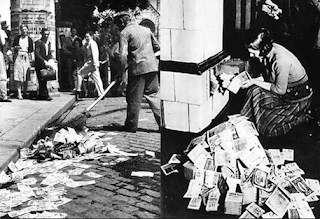Yesterday we saw how the United States implemented a plan to
replace its various debt-backed currencies (United States Notes, National Bank
Notes, and the Treasury Notes of 1890) with debt-backed Federal Reserve Bank
Notes, and replace the debt-backed Federal Reserve Bank Notes with asset-backed
Federal Reserve Notes.
 |
| "Why, this ain't complicated at all!" |
Not complicated at all!
Seriously, figuring out a way to shift from debt-backing to asset-backing without a major
disruption was an astounding accomplishment, one that experts lauded as
possibly the most important single piece of legislation in the United States
since the 1862 Homestead Act.
Unfortunately, because the politicians decided to finance the U.S. entry
into World War I on credit instead of raising taxes, the system only got to
work for two years as intended.
We won’t go into how the Federal Reserve was hijacked or how
to get it back on track, at least, not today.
Our interest right now is how Greece can put a similar program in to
place to finance production and rebuild the tax base to be able to put the
finances of the country back on a sound footing.
It’s actually much easier than the task the U.S. faced with
its multiple debt-backed currencies. All
Greece has to worry about is the Euro . . . and being “allowed” to back issues
of the Bank of Greece (the central bank of Greece) with private sector hard assets
instead of government debt paper.
 |
| Government must encourage, not discourage production. |
Even that might not be too onerous a task — getting
permission, that is — if all they are talking about is creating new demand
deposits. Given the quality of Greek
government issues versus properly vetted private sector paper, it’s a
no-brainer: go with the private sector . . . once you’ve implemented proper
controls and oversight.
We’ve already covered the first step: reform the tax system
to encourage rather than discourage production.
This is done by simplifying the tax code, and (very important) allowing
people to accumulate a capital stake on a tax-deferred basis — which we’ll look
at tomorrow. Today we want to look at
how to back the money supply with private sector assets to replace government
debt.
Conceptually, this is easy.
Instead of the central bank purchasing government bonds on the
not-so-open open market, it switches to rediscounting qualified paper backing
sound private sector loans by commercial banks, and (if that doesn’t supply
enough liquidity for the economy) purchasing qualified private sector
securities on the open market.
At the same time, the government works to start paying down
debt — which will probably take a while.
As the debt is repaid, however, new money backed with assets is issued
to replace the old money backed with debt.
 |
| Asset-backed money is not inflationary. |
Fortunately, while government debt is pure inflation,
issuing new money backed with assets is counter-inflationary. The inflationary effect of debt-backed money
will remain, but the new, asset-backed money will be neutral in its effect on
the price level, at least in theory. In
practice, there may be a brief inflationary effect for six to eighteen months —
however long it takes for new goods and services to be produced and to come on
the market, the profits from which will repay the financing and counteract the
initial inflationary spurt.
The theory is that rediscounting provides the financing for
new capital formation, and open market operations provides the financing to
clear existing inventories. The
combination of rediscounting and open market operations ensures 1) there is always
enough financing for sound new capital investment in the private sector, and 2)
there is always enough money in the economy to purchase inventories of goods. There is no room in this classic central
banking theory — the “real bills doctrine” — for backing any part of the money
supply with government debt.
That’s the theory, anyway.
In practice, you’ve got an economy with no savings to speak of that the
government can borrow, but that same government addicted to spending. It won’t be possible to go cold turkey.
That’s why Greece must institute austerity immediately,
until productive capacity can be rebuilt and the tax base starts to
recover. As we said, that will probably
be six to eighteen months before the effect becomes noticeable and the price
level stabilizes . . . and tax collections increase.
That’s the basic outline.
There is, however, one absolutely key factor that cannot be omitted from
this program — and we’ll look at it tomorrow.
